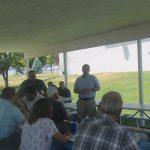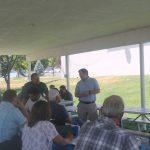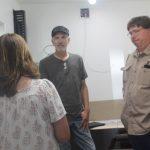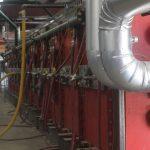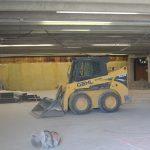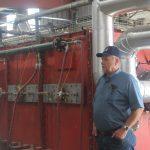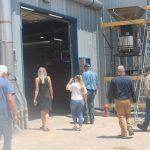By Julie Johansen
The Emery County Business Chamber’s Lunch and Learn on Wednesday focused on projects and projections for the San Rafael Energy Research Center. Commissioner Lynn Sitterud spoke briefly about the history of the research center and the impact that the pandemic had on the labs and the center’s construction. He was happy to announce that work has once again began at the facility.
Commissioner Sitterud then introduced attorney Eric Johnson, who is working on obtaining licenses for the labs from the federal and state government. He spoke about Jess Housekeeper, a local resident who works at the Hunter Plant but is also assisting at the center because of his nuclear training. Johnson excused Dr. Andrew Fry, who is also involved in the project, but was on vacation.
Dr. Matthew Memmott, an Associate Professor in the Chemical Engineering Department at Brigham Young University (BYU), then spoke about the center. Dr. Memmott’s research focuses on advanced development of innovations fuel configurations for molten salt reactors. He and Dr. Fry work together at BYU and are invaluable consultants at the research center.
Dr. Memmott spoke to a group of about 20 business owners gathered at the Orangeville Park pavilion. He explained what an amazing opportunity this center is for the development of molten salt technology and nuclear research in the field of developing medical isotopes through thorium research. Dr. Memmott stated that BYU has done some small scale work on this, but are in need of a commercial lab to continue research.
In the best case scenario, with the mandate by congress, it would take nearly six years to achieve licensure to build a molten salt reactor. In the meantime, the immediate goals of the center are to develop a perfected salt that can be used worldwide and solidify procedures for harvesting medical isotopes in the future.
While light-water uranium fueled reactors create some danger and are filling waste centers worldwide, the danger at the center is very low. The waste from a molten salt reactor is all useful bi-product that can be utilized for other purposes. When asked by someone in the audience what the dangers are for this type of reactor, Dr. Memmot replied that while they are very minimal, there could be some danger with the high heat associated with the reactors as salts melt at around 800 degrees.
In terms of funding, the commissioners explained that up to this point, most of it came from the state legislature and Community Impact Board grants. The county also has grants through the Economic Development Administration (EDA) and Department of Energy (DOE).
“Up until the new administration took office, we were having communications regarding the addition of a coal to liquid/gasification plant being constructed at the SRERC,” the commissioners shared. “This would help to research other uses of locally mined coal.”
With Pacificorp giving potential closure dates of local coal fired power plants, the commissioners were looking for alternatives to aid in lengthening the life of these plants. Commissioner Gil Conover explained to the group the importance of supercritical co2 research and how it can potentially modernize and lengthen the life of both the Hunter and Huntington Power Plants.
Several of the group then went to the research center for a tour. In the main building, (old Central Warehouse owned by PacifiCorp) two labs, one nuclear and one molten salt, are being built with hopes of completion by early next year. One corner of the building will have classrooms and lockers. In the newly-renovated shed is a coal combustion furnace where various fuel options are tested in order to research fuels that can be used in areas where coal is not allowed or readily available.
While Emery County and the State of Utah were the initial proponents of the project, Utah State University, University of Utah and BYU have all joined forces to help push the project to fruition.


